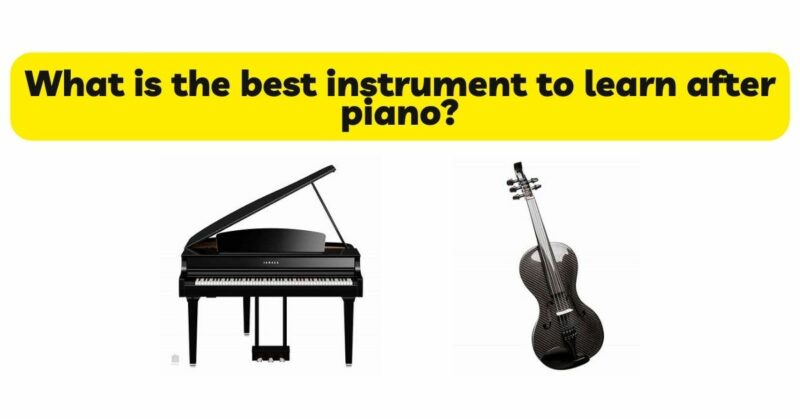Mastering the piano is a remarkable accomplishment that opens doors to endless musical possibilities. Once you have gained proficiency in playing the piano, you may find yourself yearning to explore new instruments and expand your musical horizons. The question arises: What is the best instrument to learn after piano? In this article, we will explore several popular instrument choices that complement the skills and musical knowledge acquired through piano playing. By examining the unique qualities, learning curves, and opportunities each instrument offers, we aim to guide you in selecting the ideal instrument to further your musical journey beyond the piano.
- Violin:
The violin, often considered one of the most expressive and versatile instruments, can be a natural choice for pianists. Building upon your knowledge of music theory, note reading, and ear training, the violin introduces new challenges, such as bowing technique, finger placement, and intonation. However, with its rich melodic capabilities and extensive repertoire, the violin offers a profound and emotional musical experience. It allows for intimate expression, intricate phrasing, and a deep connection to the music.
- Guitar:
The guitar, both acoustic and electric, is a popular choice for pianists seeking to broaden their musical skills. With its versatile sound and wide range of musical genres, the guitar provides a new avenue for self-expression. While the piano relies on keyboard technique, the guitar introduces a different physical approach, including fretting chords, strumming or picking strings, and understanding guitar-specific notation. The guitar’s portability and adaptability to various musical styles make it an attractive choice for pianists seeking a more versatile experience.
- Voice:
The human voice is perhaps the most intimate and expressive instrument of all. As a pianist, you already possess a solid foundation in music theory and interpretation, which can greatly benefit your vocal journey. Learning to sing involves exploring breath control, vocal techniques, and interpreting lyrics with emotion and expression. Developing your voice not only enhances your musicality but also allows you to connect directly with audiences through the power of storytelling.
- Woodwind or Brass Instruments:
Woodwind and brass instruments, such as the flute, clarinet, saxophone, trumpet, or trombone, offer unique challenges and sonic possibilities. Pianists already possess an understanding of musical notation, rhythm, and dynamics, which can ease the transition to these instruments. Woodwind and brass instruments require the development of embouchure (lip and mouth) control, breath support, and specific fingerings. These instruments offer opportunities to explore different musical styles, ensemble playing, and a vibrant range of tonal colors.
- Percussion:
For pianists who are drawn to rhythm and enjoy the percussive nature of music, percussion instruments provide a stimulating and rhythmic experience. Percussion instruments encompass a wide range, including drums, xylophone, marimba, and various handheld percussion instruments. Building upon your sense of rhythm and coordination, learning percussion requires precision in striking, timing, and understanding different percussion techniques. It offers the chance to explore diverse musical genres, from classical orchestral repertoire to world music and contemporary percussion ensembles.
- Composition and Music Production:
Expanding beyond traditional instruments, delving into composition and music production can be an exciting path for pianists. Leveraging your understanding of music theory and composition principles, you can explore the creation of original music, arranging, and orchestrating. With the advent of digital audio workstations (DAWs) and music production software, you can experiment with recording, mixing, and producing your own compositions. This avenue provides a comprehensive understanding of music production techniques, technology, and the potential to create a vast array of musical styles.
Considerations for Choosing:
When choosing the best instrument to learn after piano, several factors should be considered:
- Personal Interest: Follow your passion and choose an instrument that resonates with you. Consider the musical genres, sounds, and styles that inspire and captivate you.
- Musical Goals: Determine your musical goals, whether they involve performing, composing, or expanding your overall musicianship. Different instruments may align better with specific objectives.
- Practicality: Consider practical factors such as instrument availability, affordability, and access to instruction or resources.
- Learning Curve: Assess the instrument’s learning curve and the time and effort required to achieve proficiency. Some instruments may have steeper initial challenges, while others offer a more gradual learning curve.
- Musical Compatibility: Reflect on how the instrument of choice complements your existing piano skills and musical background. Consider how it enhances your overall musicianship and opens up new creative possibilities.
Conclusion:
Choosing the best instrument to learn after piano is a deeply personal decision. There is no one-size-fits-all answer, as it depends on your musical interests, goals, and aspirations. Whether you decide to embrace the expressive qualities of the violin, explore the rhythmic world of percussion, venture into the realm of composition and music production, or delve into another instrument entirely, each choice will offer unique challenges and rewards. Remember that the journey of learning a new instrument is an opportunity for growth, self-expression, and expanding your musical palette. Embrace the instrument that resonates with your passion, and let your musical journey continue to flourish and evolve beyond the piano.


